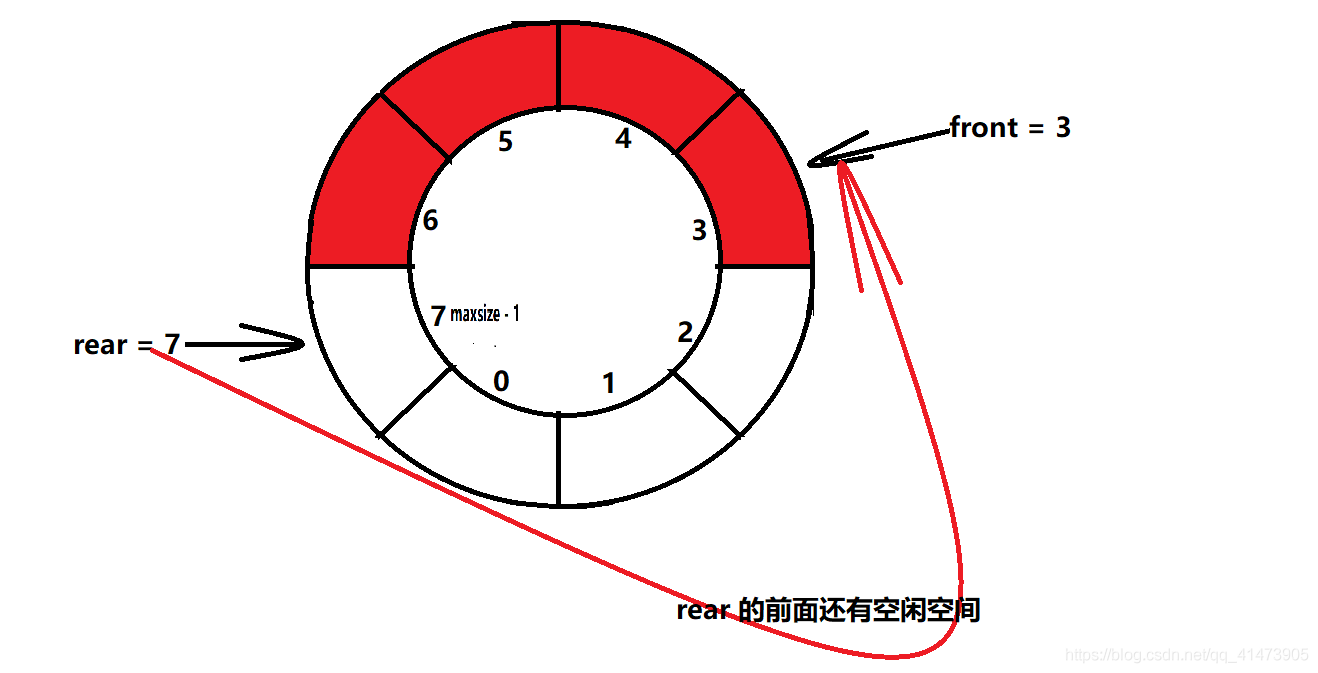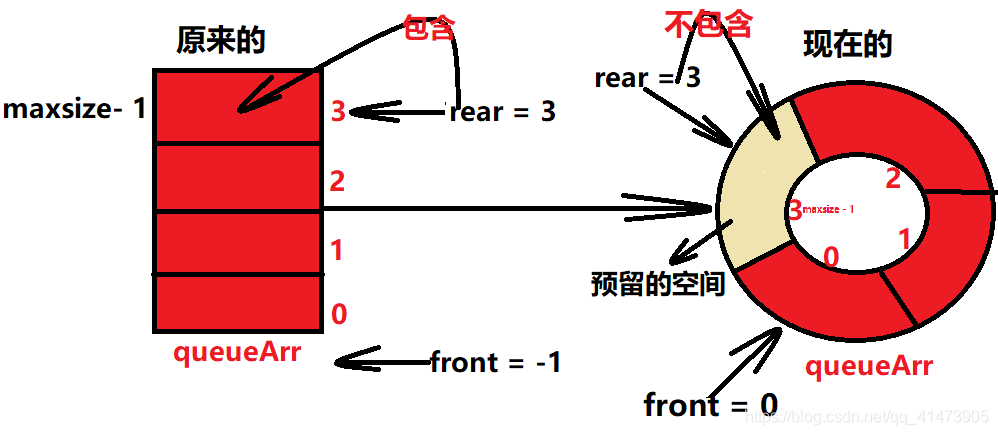队列介绍
- 队列是一个有序列表,可以用数组或是链表来实现。
遵循先入先出的原则。即:先存入队列的数据,要先取出。后存入的要后取出
数组模拟队列
思路

队列本身是有序列表,若使用数组的结构来存储队列的数据,则队列数组的声明如上图图, 其中 maxSize 是该队列的最大容量。
- 因为队列的输出、输入是分别从前后端来处理,因此需要两个变量 front及 rear分别记录队列前后端的下标,front 会随着数据输出而改变,而 rear则是随着数据输入而改变。
- front 指向队列头部,分析出front是指向队列头的前一个位置
- rear 指向队列尾部,分析出rear是指向队列尾部的数据(即队列最后一个数据)
- 将尾指针往后移:rear+1
- 当front == rear ,队列为空
- 若尾指针 rear 小于队列的最大下标 maxSize-1,则将数据存入 rear所指的数组元素中,否则无法存入数据。 当rear == maxSize - 1,说明队列已满。
示例代码
```java package com.concise.demo.data_structure.queue;
import java.util.Scanner;
/**
- 使用数组模拟一个队列
- @author shenguangyang
@date 2022-02-27 9:54 */ public class ArrayQueue { public static void main(String[] args) {
boolean loop = true;System.out.println("a [add], 添加数据");System.out.println("g [get], 获取数据");System.out.println("sa [showAll], 展示全部数据");System.out.println("sh [showHeader], 展示头部数据");System.out.println("e [exit], 退出");ArrayQueue queue = new ArrayQueue(4);Scanner scanner = new Scanner(System.in);while (loop) {String key = scanner.nextLine();switch(key) {case "a":try {System.out.print("请输入一个数字: ");int data = scanner.nextInt();queue.add(data);} catch (Exception e) {System.err.println(e.getMessage());}break;case "g":try {System.out.println(queue.get());} catch (Exception e) {System.err.println(e.getMessage());}break;case "sa":try {queue.showAll();} catch (Exception e) {System.err.println(e.getMessage());}break;case "sh":try {queue.showHeader();} catch (Exception e) {System.err.println(e.getMessage());}break;case "e":loop = false;break;default:break;}}System.out.println("程序退出了");
}
private final int[] arr; /**
- 数组队列头部 / private int front; /*
- 数组队列尾部 / private int real; /*
表示数组队列的最大容量 */ private final int maxSize;
public ArrayQueue(int maxSize) { this.maxSize = maxSize; this.arr = new int[maxSize]; // 指向队列头部,front是指向队列头部数据的前一个位置 this.front = -1; // 指向队列尾部,rear是指向队列尾部数据 this.real = -1; }
/**
- 判断队列是否已满
@return */ public boolean isFull() { // rear队列尾部数据==最大容量,说明队列已满 return this.real == this.maxSize - 1; }
/**
- 判断队列是否为空
@return */ public boolean isEmpty() { // 队列头部指针==队列尾部指针,说明队列为空 return this.real == this.front; }
public void add(int data) { if (this.isFull()) {
throw new RuntimeException("队列已经满了");
} // 队列尾部指针向后移 this.real = this.real + 1; this.arr[this.real] = data; }
public int get() { if (this.isEmpty()) {
throw new RuntimeException("队列为空");
} // 队列头部指针向后移动 this.front = this.front + 1; return this.arr[this.front]; }
public void showAll() { if (this.isEmpty()) {
throw new RuntimeException("队列为空");
} for (int i = 0; i < this.arr.length; i++) {
System.out.printf("\tarr[%d] = %d\n", i, this.arr[i]);
} }
public void showHeader() { if (this.isEmpty()) {
throw new RuntimeException("队列为空");
} System.out.printf(“\tarr[%d] = %d\n”, this.front + 1, this.arr[this.front + 1]); } } ```
测试结果如下
a [add], 添加数据g [get], 获取数据sa [showAll], 展示全部数据sh [showHeader], 展示头部数据e [exit], 退出a请输入一个数字: 10saarr[0] = 10arr[1] = 0arr[2] = 0arr[3] = 0sharr[0] = 10a请输入一个数字: 20saarr[0] = 10arr[1] = 20arr[2] = 0arr[3] = 0sharr[0] = 10a请输入一个数字: 30a请输入一个数字: 40a请输入一个数字: 50队列已经满了saarr[0] = 10arr[1] = 20arr[2] = 30arr[3] = 40g10g20g30sharr[3] = 40g40sh队列为空e程序退出了Process finished with exit code 0
问题分析并优化思路
问题:目前数组使用一次就不能用,没有达到复用的效果
优化思路:将这个数组使用算法,改进成一个环形的队列 取模的方式
当数据从队列全部取出之后,再添加数据, 不能添加, 说明数组使用一次就不能再次使用,没有达到复用效果
数组模拟环形队列
实现:让数组达到复用的效果,即:当我们从数组队列中取出了数据,那取出数据后后这个空间可以再次使用
思路分析
当rear指针指向maxsize - 1时,也就是当rear = maxsize - 1 时,需要判断rear的前面是否有空闲空间,也就是说front是否产生了变化并且已经不在初始的那个位置了

思路如下:
- front的含义做调整 :front由原来的指向队列头的前一个位置调整为现在的front指向了队列头
- 队列头:就是队列中第一个数据所在的位置
- 即:queueArr[front]就是获取的队列中的第一个数据

说明:
- 原来front的初始值为 - 1 现在 front 的初始值为0
原来的front是不包含队列头的,现在的front是包含队列头的
rear的含义做调整:rear从原来指向队列的最后一个数据调整为了现在的rear指向队列的最后一个数据的前一个位置
- 调整rear的目的:预留一个空间作为约定

说明:
- 原来的rear的初始值为 - 1,现在的rear的初始值为0
- 原来的rear包含队列的最后一个数据,现在的rear是不包含队列的最后一个数据。
- 预留的空间是动态变化的,预留空间始终都在rear指向的最后一个数据的后一个位置
- rear和front含义发生调整后,判断队列满的条件是( rear + 1 )% maxsize = front
- 为什么要取模? 答:因为rear可能是一直增长的,从而达到数组空间复用的效果, 如果不进行取模会出现数组越界情况
- 原先队列满的条件是rear = maxsize - 1 因为 原先没有考虑数组空间的复用

- 判断队列为空的条件是rear = front

经过以上分析
- 当rear和front含义发生调整后,队列中有效数据的个数 是 (rear + maxsize - front) % maxsize
- 为什么要取模?答:因为是环形队列,rear有可能指到队列最前面。
- 为什么要加上maxsize?
- 因为是环形队列,rear有可能指到队列最前面, 所以 rear - front 很有可能为负数, 这时候
(rear - front) + maxsize就是有效个数, 如果不为负数, 需要进行 % maxsize, 才能保证结果为有效个数
- 因为是环形队列,rear有可能指到队列最前面, 所以 rear - front 很有可能为负数, 这时候
- 打个比方,当rear = 0,maxsize = 4 ,front = 0时,该队列中有多少个有效的数据?

分析:(0 + 3 - 0)% 3 = 0,该队列中有效的数据个数为0个,因为rear = front ,则证明是空队列
代码实现
package com.concise.demo.data_structure.queue;import java.util.Scanner;/*** 使用数组模拟一个环形队列* @author shenguangyang* @date 2022-02-27 9:54*/public class CirCleArrayQueue {public static void main(String[] args) {boolean loop = true;System.out.println("a [add], 添加数据");System.out.println("g [get], 获取数据");System.out.println("sa [showAll], 展示全部数据");System.out.println("sh [showHeader], 展示头部数据");System.out.println("e [exit], 退出");CirCleArrayQueue queue = new CirCleArrayQueue(4);Scanner scanner = new Scanner(System.in);while (loop) {String key = scanner.nextLine();switch(key) {case "a":try {System.out.print("请输入一个数字: ");int data = scanner.nextInt();queue.add(data);} catch (Exception e) {System.err.println(e.getMessage());}break;case "g":try {System.out.println(queue.get());} catch (Exception e) {System.err.println(e.getMessage());}break;case "sa":try {queue.showAll();} catch (Exception e) {System.err.println(e.getMessage());}break;case "sh":try {queue.showHeader();} catch (Exception e) {System.err.println(e.getMessage());}break;case "e":loop = false;break;default:break;}}System.out.println("程序退出了");}private final int[] arr;/*** front 调整后的含义为: 指向队列头(即:队列中的第一个数据),front的初始值为 0*/private int front;/*** rear 调整后的含义为:指向队列中的最后一个数据的前一个位置 ,rear 的初始值为0*/private int real;/*** maxsize 表示队列的最大容量,队列中的数据是存放在数组中的*/private final int maxSize;public CirCleArrayQueue(int maxSize) {this.maxSize = maxSize;this.arr = new int[maxSize];this.front = 0;this.real = 0;}/*** 判断队列是否已满*/public boolean isFull() {return (this.real + 1) % maxSize == this.front;}/*** 判断队列是否为空*/public boolean isEmpty() {return this.real == this.front;}public void add(int data) {if (this.isFull()) {throw new RuntimeException("队列已经满了");}this.arr[this.real] = data;this.real = (this.real + 1) % this.maxSize;}public int get() {if (this.isEmpty()) {throw new RuntimeException("队列为空");}// 第一步 先把queueArr[front]对应的保存在一个临时变量中// 为什么要将queueArr[front]对应的保存在一个临时变量中? 因为 若直接返回的话,就没有往后移的机会了int value = this.arr[this.front];this.front = (this.front + 1) % this.maxSize;return value;}public void showAll() {if (this.isEmpty()) {throw new RuntimeException("队列为空");}for (int i = front; i < front + size(); i++) {System.out.printf("\tarr[%d] = %d\n", i % this.maxSize, this.arr[i % this.maxSize]);}}public void showHeader() {if (this.isEmpty()) {throw new RuntimeException("队列为空");}System.out.printf("\tarr[%d] = %d\n", this.front, this.arr[this.front]);}public int size() {return (this.real + this.maxSize - this.front) % this.maxSize;}}

